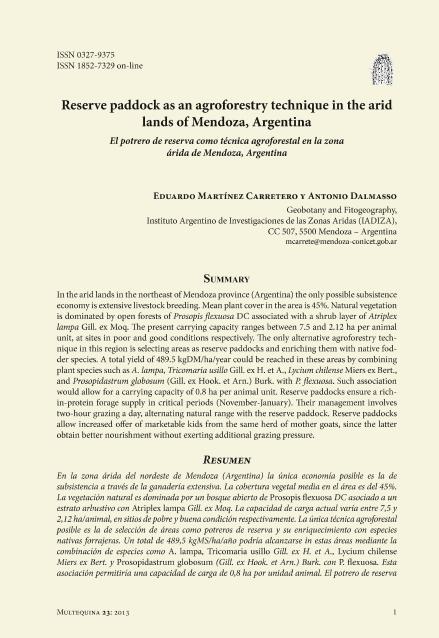Artículo
In the arid lands in the northeast of Mendoza province (Argentina) the only possible subsistence economy is extensive livestock breeding. Mean plant cover in the area is 45%. Natural vegetation is dominated by open forests of Prosopis flexuosa DC associated with a shrub layer of Atriplex lampa Gill. ex Moq. The present carrying capacity ranges between 7.5 and 2.12 ha per animal unit, at sites in poor and good conditions respectively. The only alternative agroforestry technique in this region is selecting areas as reserve paddocks and enriching them with native fodder species. A total yield of 489.5 kgDM/ha/year could be reached in these areas by combining plant species such as A. lampa, Tricomaria usillo Gill. ex H. et A., Lycium chilense Miers ex Bert., and Prosopidastrum globosum (Gill. ex Hook. et Arn.) Burk. with P. flexuosa. Such association would allow for a carrying capacity of 0.8 ha per animal unit. Reserve paddocks ensure a richin- protein forage supply in critical periods (November-January). Their management involves two-hour grazing a day, alternating natural range with the reserve paddock. Reserve paddocks allow increased offer of marketable kids from the same herd of mother goats, since the latter obtain better nourishment without exerting additional grazing pressure. En la zona árida del nordeste de Mendoza (Argentina) la única economía posible es la de subsistencia a través de la ganadería extensiva. La cobertura vegetal media en el área es del 45%. La vegetación natural es dominada por un bosque abierto de Prosopis flexuosa DC asociado a un estrato arbustivo con Atriplex lampa Gill. ex Moq. La capacidad de carga actual varía entre 7,5 y 2,12 ha/animal, en sitios de pobre y buena condición respectivamente. La única técnica agroforestal posible es la de selección de áreas como potreros de reserva y su enriquecimiento con especies nativas forrajeras. Un total de 489,5 kgMS/ha/año podría alcanzarse in estas áreas mediante la combinación de especies como A. lampa, Tricomaria usillo Gill. ex H. et A., Lycium chilense Miers ex Bert. y Prosopidastrum globosum (Gill. ex Hook. et Arn.) Burk. con P. flexuosa. Esta asociación permitiría una capacidad de carga de 0,8 ha por unidad animal. El potrero de reserva asegura un suplemento forrajero rico en proteína en los períodos críticos (noviembre-enero). Su manejo involucra dos horas diarias de pastoreo, alternando con la vegetación natural. El potrero de reserva permite incrementar la oferta de crías al mercado, al lograr las madres mejor nutrición.
Reserve paddock as an agroforestry technique in the arid lands of Mendoza, Argentina
Título:
El potrero de reserva como técnica agroforestal en la zona árida de Mendoza, Argentina
Fecha de publicación:
12/2014
Editorial:
Instituto Argentino de Investigaciones de las Zonas Aridas
Revista:
Multequina
ISSN:
0327-9375
e-ISSN:
1852-7329
Idioma:
Inglés
Tipo de recurso:
Artículo publicado
Clasificación temática:
Resumen
Palabras clave:
Fodder Species
,
Forest
,
Gotas
,
Management
Archivos asociados
Licencia
Identificadores
Colecciones
Articulos(IADIZA)
Articulos de INST. ARG DE INVEST. DE LAS ZONAS ARIDAS
Articulos de INST. ARG DE INVEST. DE LAS ZONAS ARIDAS
Citación
Martinez Carretero, Eduardo Enrique; Dalmasso, Antonio Daniel; Reserve paddock as an agroforestry technique in the arid lands of Mendoza, Argentina; Instituto Argentino de Investigaciones de las Zonas Aridas; Multequina; 23; 12-2014; 1-12
Compartir




